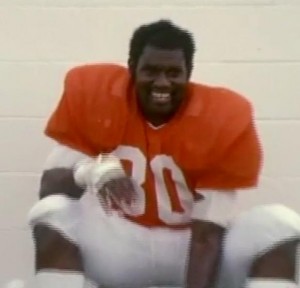2015: Art Powell, Member of Legendary Family
Oakland Raiders managing general partner Al Davis spoke in 2006 about Art Powell, whom Davis signed out of the Canadian Football League years before.
“I wish I could take you back to 1963,” said Davis, “because I had one of the greatest receivers who have ever played this game. His first year for me, he carried us.”
Powell caught 73 passes and scored 16 touchdowns as the Raiders, under first-year coach Davis, improved their record from 2-12 to 10-4.
Powell played one season in Canada and 10 seasons in the AFL and NFL and was a member of the all-American Football League team for the decade of the league’s existence, 1960-69.

Powell recently passed away at age 78 in Aliso Viejo in Orange County, where he and his family had resided many years.
A 6-foot, 3-inch, 210-pound receiver as a professional, Powell was the third in arguably the most gifted family of athletes in San Diego history.
His older brother Charlie earned an unequaled 12 varsity letters at San Diego High. Ellsworth Powell was a standout basketball player at San Diego, and younger brother Jerry was the San Diego Section football player of the year at Lincoln in 1967.
Art Powell caught 479 passes in his NFL-AFL career. His 81 touchdowns represented one touchdown for every 5.9 catches.
Powell was all-Southern California in 1954 at San Diego and was the City League player of the year in basketball in 1954-55.
A proud and principled man, Powell stood up when others sat.
Powell was one of the first to balk when black players were not allowed to stay in white hotels with the rest of their teammates in the days when pro athletes experienced segregation and discrimination.
Powell was on the verge of quitting at San Diego High in 1954, upset at head coach Duane Maley, who had elevated Powell from the junior varsity in 1953 but then played Powell sparingly.
It was Powell’s teammate; quarterback Pete Gumina, who prevailed on the youngster to stick it out. Powell responded with an outstanding season.
As a sportswriter for the San Diego Evening Tribune, I interviewed Powell after the Raiders had beaten the Chargers, 34-33, in Balboa Stadium in 1963.
When I asked Powell who had been the most significant person in his athletic development, I expected him to identify Maley or basketball coach Merrill Douglas.
But Powell pointed to Augie Escamilla, a coach at the Boys’ Club on Marcy Avenue, not far from the youngster’s home in Logan Heights.
Art had gotten his inspiration from the energetic and encouraging Escamilla, who coached all of the Boys’ Club teams and all of the great athletes who would graduate from those playing fields known as the 40 acres.
JIMMY GUNN, LINCOLN AND USC’S ‘WILD BUNCH’
James (Jimmy) Gunn, a star on Lincoln’s San Diego Section championship team and a member of 3 USC Rose Bowl teams and the “Wild Bunch” defensive line, was 66 when he passed in Los Angeles this month.
Lincoln posted a 10-1 record and defeated Point Loma, 21-14, for the Division 1-A title in 1965.

The 200-pound Gunn also was talked into going out for track in his senior season by coach Bobby Smith, became a 50-second quartermiler, and ran on some of Lincoln’s fast sprint relay squads.
As a starting defensive end and all-America in 1969, Gunn starred on a USC unit that was named after the title of a popular shoot-‘em-up movie of the day, “The Wild Bunch”.
Gunn was selected in the 12th round of the 1970 NFL draft by the Chicago Bears and played seven seasons in the NFL.